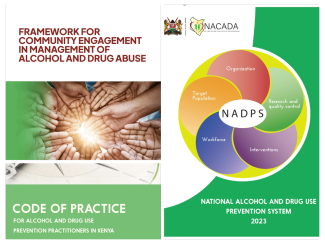Kenya Substance Use Prevention Shaping Up

In 2021, Kenya through the National Authority for the Campaign against Alcohol and Drug Abuse (NACADA) developed the National Guidelines on Alcohol and Drug Use Prevention. The goal of the Guidelines was to establish minimum requirements for conducting drug use prevention programs in schools, families, workplaces, communities, and the media in Kenya. Specifically, it was to:
- Advise on the best practices in prevention interventions and policies,
- Ensure professionalism in planning and implementation of prevention interventions;
- Provide guidelines and minimum requirements for service providers to ensure recipients of prevention interventions are protected;
- Foster the development of a national prevention system that will support children, youth, and adults in different settings to lead positive, healthy lifestyles.
Since the launch of the Guidelines in June 2022, NACADA as the lead agency mandated to coordinate drug demand reduction programs in Kenya, embarked on the operationalization of the above objectives aimed at ensuring healthy and safe development of children and young people.
This process began with the development and dissemination of the Framework for Community Engagement in the Management of Alcohol and Drug Abuse, 2022 which guides community workgroups engagement and promotes common understanding as well as strengthens collaboration and partnership in drug demand reduction interventions.
This Framework advocates for community workgroups to connect, collaborate and develop policies and strategies for prevention, treatment, and aftercare at the community level. By working together, they shall initiate positive changes that reduce the socioeconomic and health consequences of substance use and alter socio-cultural norms that promote substance use.
It also guides on the steps of setting up community workgroups, promotes capacity development and outreach, outlines ethical considerations, and emphasizes the need for monitoring, evaluation, and reporting.
After the Framework, NACADA in liaison with key stakeholders, embarked on ensuring professionalism and implementation of prevention interventions. Despite the positive strides made towards evidence-based interventions and engagement of professionals, there have been cases of “quacks” masquerading as professionals resulting in them doing more harm than good. To rationalize who should be engaged in the field of drug use prevention, the Code of Practice for Alcohol and Drug Use Prevention Practitioners in Kenya was born.
The Code seeks to guide and regulate the performance of alcohol and drug use prevention practitioners as well as ensure professionalism in the planning and implementation of prevention interventions. Just like the Framework, it is guided by the values of prevention, acknowledges the classification of prevention strategies, and lays out the purpose.
The Code of Practice appreciates that there are many involved in prevention work but there is a need to standardize knowledge and practice of interventions for positive and sustainable outcomes. It is applicable to target groups and functions in the line of prevention. Its uniqueness is that it guides the knowledge, competence, and tasks of prevention practitioners. So, are you a Prevention Coordinator or a Prevention Specialist? Using the laid-out criteria you can find who you are, what it takes to be either a Practitioner or Specialist, and the tasks and responsibilities you should be undertaking. Best of luck!
Finally, did you know that despite having a Framework and being a Prevention Practitioner there is a need to have a Prevention System? Before we embark on what is a Prevention System, let us look at the current situation. Kenya like many countries across the world is a signatory of the three International Conventions on Drug Control (1961, 1971 & 1988) and this automatically translates to Kenya submitting annual reports on drug demand reduction and supply suppression to UNODC and the African Union Commission (AUC). At the local level, NACADA prepares and submits bi-annual status reports on alcohol and drug abuse control to both Houses of Parliament. Worth noting is that largely the focus of these reports is drug supply suppression and this creates a gap in drug demand reduction reporting. This is where the National Alcohol and Dru Use Prevention System comes in.
Simply put, the System provides a national observatory for drug use prevention data in Kenya. It is a starting point for collecting, analyzing, disseminating, and adaptation of effective approaches to alcohol and drug use prevention in Kenya. It details the functions and components of a prevention system, provides a menu of prevention interventions, information needed by various stakeholders as well as their roles and responsibilities in drug use prevention.
Armed with National Guidelines, a Community Engagement Framework, a Code of Practice, and a National Prevention System on alcohol and drug use, Kenya is headed in the right direction of evidence-based programming geared towards delaying or avoiding initiation into substance use and for those that have started ensuring that they do not progress to dependency.